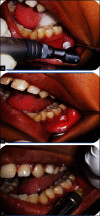Anesthetic efficacy of X-tip intraosseous injection using 2% lidocaine with 1:80,000 epinephrine in patients with irreversible pulpitis after inferior alveolar nerve block: A clinical study
- PMID: 23716971
- PMCID: PMC3659864
- DOI: 10.4103/0972-0707.108202
Anesthetic efficacy of X-tip intraosseous injection using 2% lidocaine with 1:80,000 epinephrine in patients with irreversible pulpitis after inferior alveolar nerve block: A clinical study
Abstract
Introduction: The inferior alveolar nerve block (IAN) is the most frequently used mandibular injection technique for achieving local anesthesia in endodontics. Supplemental injections are essential to overcome failure of IAN block in patients with irreversible pulpitis.
Aim: To evaluate the anesthetic efficacy of X-tip intraosseous injection (2% lidocaine with 1:80,000 epinephrine) in patients with irreversible pulpitis in mandibular posterior teeth when conventional IAN block failed.
Materials and methods: Thirty emergency patients diagnosed with irreversible pulpitis in a mandibular posterior tooth received an IAN block and experienced moderate to severe pain on endodontic access or initial instrumentation. The X-tip system was used to administer 1.8 ml of 2% lidocaine with 1:80,000 epinephrine. The success of X-tip intraosseous injection was defined as none or mild pain (Heft-Parker visual analogue scale ratings < 54 mm) on endodontic access or initial instrumentation.
Results: Ninety-three percent of X-tip injections were successful and 7% were unsuccessful. Discomfort rating for X-tip perforation: 96.66% patients reported none or mild pain, whereas 3.34% reported moderate to severe pain. For discomfort rating during solution deposition, 74.99% patients reported none or mild pain and 24.92% reported moderate to severe pain. Ninety-six percent of the patients had subjective/objective increase in heart rate.
Conclusions: Supplemental X-tip intraosseous injection using 2% lignocaine with 1:80,000 epinephrine has a statistically significant influence in achieving pulpal anesthesia in patients with irreversible pulpitis.
Keywords: Anesthetic failure; X-tip system; heft-Parker “visual analogue scale” pain scale; intraosseous anesthesia; irreversible pulpitis; technical failure.
Conflict of interest statement
Figures


References
-
- Haas DA. An update on local anesthetics in dentistry. J Can Dent Assoc. 2002;68:546–51. - PubMed
-
- Hargreaves KM, Kaiser K. Local anesthetic failure in endodontics; mechanisms and management. Endod Top. 2002;1:26–39.
-
- Guglielmo A, Reader A, Nist R, Beck M, Weaver J. Anesthetic efficacy and heart rate effects of the supplemental intraosseous injection of 2% mepivacaine with 1:20,000 levonordefrin. Oral Surg Oral Med Oral Pathol Oral Radiol Endod. 1999;87:284–93. - PubMed
-
- Hargreaves KM. Neurochemical factors in injury and inflammation in orofacial tissues. In: Lavigne G, Lund J, Sessle B, Dubner R, editors. Orofacial Pain: Basic Sciences to Clinical Management. Chicago: Quintessence; 2001. pp. 45–52.
-
- Nakai Y, Milgrom P, Mancl L, Coldwell SE, Domoto PK, Ramsay DS. Effectiveness of local anesthesia in pediatric dental practice. J Am Dent Assoc. 2000;131:1699–05. - PubMed
LinkOut - more resources
Full Text Sources
Other Literature Sources

